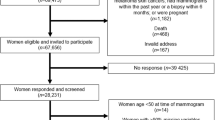Abstract
Background
The mechanism by which pregnancy impacts breast cancer risk remains poorly understood. There is a need for detailed quantification of risk in nulliparous women. We therefore have undertaken a case-referent study of breast cancer employing data from the Hospital-based Epidemiologic Research Program at Aichi Cancer Center (HERPACC), Japan, examining the impact of reproductive and anthropometric factors on breast cancer risk among nulligravid women compared with their parous counterparts.
Methods
In total, 2,032 breast cancer cases were included, and 17,848 women, confirmed as free of cancer, were recruited as a reference group. Odds ratios (OR) and 95% confidence intervals (95% CI) were determined by multiple logistic regression analysis.
Results
A protective effect of later age at menarche was observed among parous women, but it did not alter risk in nulligravid cases. The risk increment with a family history appeared to be most pronounced among premenopausal cases with no history of pregnancy (OR=2.68, 95% CI: 1.41-5.11). Among postmenopausal women, positive associations with height and current body mass index (BMI) in the nulligravid group were similar to those observed in the parous group. The present study indicated that age at menopause, family history in premenopausal women, and height and obesity in postmenopausal women seemed to exert more influence in nulligravid women. Formal tests for interaction between maternity status and these factors, however, did not prove statistically significant.
Conclusion
Our findings suggest that established risk factors for breast cancer have an additive impact with nulligravid status. Thus, it is implied that obesity control for all women, including nulliparous individuals, is important from a practical viewpoint for primary breast cancer prevention.
Similar content being viewed by others
Abbreviations
- BMI:
-
Body mass index
- OR:
-
Odds ratio
- CI:
-
Confidence interval
References
Hirose K, Tajima K, Hamajima N,et al: A large-scale, hospital-based case-control study of risk factors of breast cancer according to menopausal status.Jpn J Cancer Res 86: 146–154, 1995.
Hirose K, Tajima K, Hamajima N,et al: Effect of body size on breast-cancer risk among Japanese women.Int J Cancer 80: 349–355, 1999.
Hirose K, Tajima K, Hamajima N,et al: Association of family history and other risk factors with breast cancer risk among Japanese premenopausal and postmenopausal women.Cancer Causes and Control 12: 349–358, 2001.
Kelsey JL, Gammon MD, John EM: Reproductive factors and breast cancer.Epidemiol Rev 15: 36–47, 1993.
Yoo K-Y, Tajima K, Kuroishi T,et al: Independent protective effect of lactation against breast cancer: a case-control study in Japan.Am J Epidemiol 135: 726–733, 1992.
Hamajima N, Hirose K, Inoue M,et al: Age-specific risk factors of breast cancer estimated by a case-control study in Japan.J Epidemiol 5: 99–105, 1995.
Inoue M, Tajima K, Hirose K,et al: Epidemiological features of first-visit outpatients in Japan: comparison with general population and variation by sex, age, and season.J Clin Epidemiol 50: 69–77, 1997.
Hirose K, Tajima K, Hamajima N,et al: Impact of family history on the risk of breast cancer among the Japanese.Jpn J Cancer Res 88: 1130–1136, 1997.
Tominaga S, Kuroishi T: High-risk group for breast cancer: recent results.J Jpn Assoc Breast Cancer Screen 7: 187–195, 1998 (in Japanese).
Hamajima N, Hirose K, Inoue M,et al: Case-control studies: matched controls or all available controls?J Clin Epidemiol 47: 971–975, 1994.
Weiss HA, Troisi R, Rossing MA,et al: Fertility problems and breast cancer risk in young women: a casecontrol study in the United States.Cancer Causes Control 9: 331–339, 1998.
Daling JR, Malone KE, Voigt LF,et al: Risk of breast cancer among young women: relationship to induced abortion.J Natl Cancer Inst 86: 1584–1592, 1994.
Brind J, Chinchilli VM, Severs WB,et al: Induced abortion as an independent risk factor for breast cancer: a comprehensive review and meta-analysis.J Epidemiol Community Health 50: 481–496, 1996.
Newcomb PA, Storer BE, Longnecker MP,et al: Pregnancy termination in relation to risk of breast cancer.JAMA 275: 283–287, 1996.
Rookus MA, vanLeeuwen FE: Induced abortion and risk for breast cancer: reporting (recall) bias in a Dutch case-control study.J Natl Cancer Inst 88: 1759–1764, 1996.
Peeters PHM, Verbeek ALM, Krol A,et al: Age at menarche and breast cancer risk in nulliparous women.Breast Cancer Res Treat 33: 55–61, 1994.
Fioretti F, Tavani A, Bosetti C,et al: factors for breast cancer in nulliparous women.Brit J Cancer 79: 1923–1928, 1999.
MacMahon B, Trichopoulos D, Brown J,et al: Age at menarche, urine estrogens and breast cancer risk.Int J Cancer 30: 427–431, 1982.
Apter D, Reinila M, Vihko R: Some endocrine characteristics of early menarche, a risk factor for breast cancer, are preserved into adulthood.Int J Cancer 44: 737–787, 1989.
Andriew N, Demenais F: Interactions between genetic and reproductive factors in breast cancer risk in a French family sample.Am J Hum Genet 61: 678–690, 1997.
Willett WC, Browne ML, Bain C,et al: Relative weight and risk of breast cancer among pre-menopausal women.Am J Epidemiol 122: 731–740, 1985.
Le Marchand L, Kolonel LN, Earle ME,et al: Body size at different periods of life and breast-cancer risk.Am J Epidemiol 128: 137–152, 1988.
Vatten LJ, Kvinnsland S: Body-mass index and risk of breast cancer. A prospective study of 23,826 Norwegian women.Int J Cancer 45: 440–444, 1990.
Kirschner MA, Ertel N, Schneider G: Obesity, hormones and cancer.Cancer Res 41: 3711–3717, 1981.
Zumoff B: Relationship of obesity to blood estrogen.Cancer Res 42: 3289s-3294s, 1982.
Bruning PF: Endogenous estrogens and breast cancer; a possible relationship between body-fat distribution and estrogen availability.J Steroid Biochem 27: 487–492, 1987.
Author information
Authors and Affiliations
Corresponding author
Additional information
Reprint requests to Kaoru Hirose, Division of Epidemiology and Prevention, Aichi Cancer Center Research Institute, 1-1, Kanokoden Chikusa-ku, Nagoya 464-8681, Japan.
About this article
Cite this article
Hirose, K., Tajima, K., Hamajima, N. et al. Impact of established risk factors for breast cancer in nulligravid Japanese women. Breast Cancer 10, 45–53 (2003). https://doi.org/10.1007/BF02967625
Received:
Accepted:
Issue Date:
DOI: https://doi.org/10.1007/BF02967625



